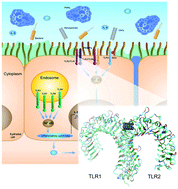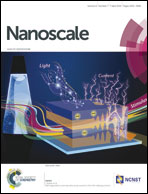Immunotoxicity of nanoparticles: a computational study suggests that CNTs and C60 fullerenes might be recognized as pathogens by Toll-like receptors†
Abstract
Over the last decade, a great deal of attention has been devoted to study the inflammatory response upon exposure to multi/single-walled carbon nanotubes (CNTs) and different fullerene derivatives. In particular, carbon nanoparticles are reported to provoke substantial inflammation in alveolar and bronchial epithelial cells, epidermal keratinocytes, cultured monocyte–macrophage cells, etc. We suggest a hypothetical model providing the potential mechanistic explanation for immune and inflammatory responses observed upon exposure to carbon nanoparticles. Specifically, we performed a theoretical study to analyze CNT and C60 fullerene interactions with the available X-ray structures of Toll-like receptors (TLRs) homo- and hetero-dimer extracellular domains. This assumption was based on the fact that similar to the known TLR ligands both CNTs and fullerenes induce, in cells, the secretion of certain inflammatory protein mediators, such as interleukins and chemokines. These proteins are observed within inflammation downstream processes resulted from the ligand molecule dependent inhibition or activation of TLR-induced signal transduction. Our computational studies have shown that the internal hydrophobic pockets of some TLRs might be capable of binding small-sized carbon nanostructures (5,5 armchair SWCNTs containing 11 carbon atom layers and C60 fullerene). High binding scores and minor structural alterations induced in TLR ectodomains upon binding C60 and CNTs further supported our hypothesis. Additionally, the proposed hypothesis is strengthened by the indirect experimental findings indicating that CNTs and fullerenes induce an excessive expression of specific cytokines and chemokines (i.e. IL-8 and MCP1).


 Please wait while we load your content...
Please wait while we load your content...